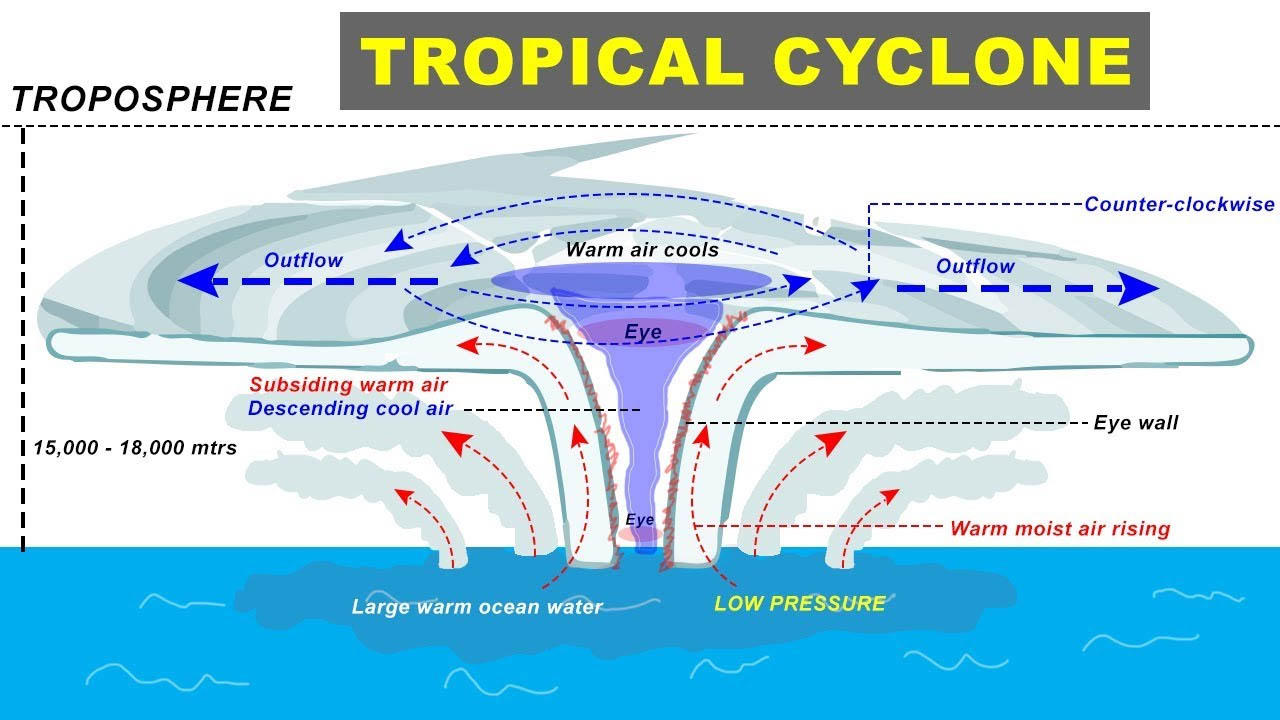-
31 Mar 2025
GS Paper 2
Geography & Economy
Day 25: Discuss the formation and key characteristics of tropical cyclones. Also analyze their socio-economic and environmental impacts, particularly in the Indian context. (38 marks)
Approach
- In the introduction, briefly define tropical cyclones.
- Mention the formation, characteristics, and impacts of tropical cyclones.
- Conclude accordingly.
Introduction
Tropical cyclones are intense low-pressure systems that form over warm tropical oceans and are marked by high-speed winds, heavy rainfall, and spiral cloud bands. In the Indian Ocean, they are simply called tropical cyclones, unlike hurricanes (Atlantic) or typhoons (Pacific and Southeast Asia).
Body
- Formation of Tropical Cyclones:
- Begins over warm ocean surfaces above 26.5°C, where intense heating causes evaporation and uplift of moist air.
- Initial development involves rising convection currents, forming cumulus clouds and low-pressure zones.
- In the mature stage, a well-defined eye forms due to subsidence of air and intense latent heat release.
- Wind speeds increase around the eye wall, while dense cumulonimbus bands develop around the center.
- Cyclones weaken over land or cooler waters, as energy from warm oceans is cut off, leading to decay.
- Key Characteristics of Tropical Cyclones:
- Warm Core System: The center of the cyclone is warmer than surrounding areas due to latent heat.
- Low Atmospheric Pressure: The eye of the cyclone has the lowest pressure, causing inward air movement.
- Strong Spiral Winds: Wind speed is highest around the eye wall and decreases outward; it can exceed 200 kmph.
- Heavy Rainfall and Flooding: Caused by moisture-laden updrafts and condensation; results in flash floods and landslides.
- Closed Isobars: Weather maps show tightly packed circular isobars around the low-pressure core.
- Eye and Eye Wall: The eye is calm, while the eye wall experiences the most violent weather.
- Storm Movement Influenced by Global Winds: Cyclones often move westward and curve poleward under Coriolis force.
- Dissipation Occurs Over Land or Cold Waters: Without warm moisture input, cyclones weaken rapidly.
- Socio-Economic and Environmental Impacts (with Indian Context):
- Heavy Rainfall and Flooding: Cyclone Yaas (2021) flooded parts of Odisha and West Bengal, affecting agriculture and housing.
- Storm Surge: Cyclone Tauktae (2021) led to 3–4 m high sea surges along the Gujarat coast, inundating low-lying areas.
- Loss of Life and Livelihood: Cyclones often displace millions; Cyclone Amphan (2020) affected over 1 crore people in Bengal.
- Coastal Erosion: Repeated cyclonic events have degraded India's eastern coastline, altering natural landforms.
- Environmental Damage: Cyclones destroy mangroves, wetlands, and contaminate freshwater sources through saline intrusion.
- Economic Disruptions: Crops, fisheries, ports, power, and communication lines face heavy damage, burdening recovery efforts.
- Public Health Risks: Floodwaters increase the spread of diseases like cholera, dengue, and diarrheal infections post-cyclone.
- High Vulnerability of Coastal India: 32 crore people across 9 coastal states are cyclone-prone due to India’s 7,516 km coastline.
- Disproportionate Impact on the Poor: Marginal communities, particularly in Odisha and Andhra Pradesh, suffer severe economic losses.
- Increased Frequency and Intensity: Rising sea surface temperatures due to climate change have intensified cyclone occurrence in Bay of Bengal and Arabian Sea.
Conclusion
Tropical cyclones, while natural in origin, have devastating human, ecological, and economic consequences, especially in India’s coastal regions. With climate change enhancing their intensity, there is an urgent need for early warning systems, disaster-resilient infrastructure, and community-level preparedness to reduce the toll of these extreme events.





